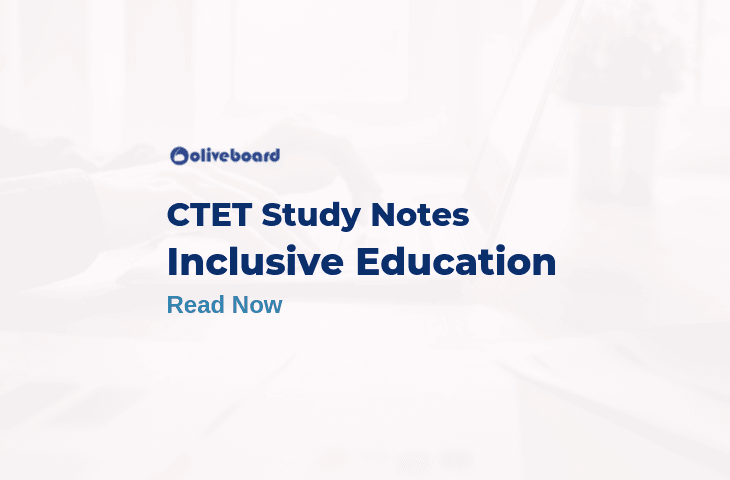The Central Board of Secondary Education conducts the the Central Teacher Eligibility Test CTET in July & December every year. This test is meant for those people who want to be part of the teaching cadre at Central Government schools. Since a teacher’s task is to impart education and learning, the CTET exams will thoroughly determine if the candidate has the aptitude to take on this responsibility. That is why it is desirable for candidates to thoroughly grasp the different subject matters of the CTET syllabus. Child Development and Pedagogy is a crucial segment of both CTET Paper 1 and Paper 2. Today we will provide you with detailed Inclusive Education Notes, an important part of the Child Development and Pedagogy syllabus to help you with your CTET preparation.
Join the FREE CTET Online Course Now to Kick-start your preparation
Inclusive Education Notes – What is Inclusive Education?
Inclusive education is essentially a classroom model. In this classroom, children with special needs (with learning disabilities) are taught alongside students without learning disabilities. Disabilities can include vision loss, walking or posture impairment, speech and language developmental issues, hearing problems etc. The children with special education requirement spend most of their time in school mingling with non-special needs children. This model often requires the co-teaching facility, which means that both a special education teacher and general education teacher are present in the same classroom and teach together. That is why this approach is also called Integrated Co-Teaching (ICT) or Collaborative Team Teaching (CTT).
What sets inclusive classrooms apart from self-contained classrooms is that the special needs children in the former are classified as students with mild-moderate disabilities. Students in self-contained classes, however, are considered to have significant or multiple learning disabilities. In fact, the inclusion model is based on the rejection of specific classrooms for children with disabilities because segregation harms all students.
Inclusive Education Notes – Principles
The chief objectives of this model of education are –
- To tear down all hurdles to participation and learning that children with special needs face
- Protect the interests of all students without discrimination
- Provide equal access to education to empower all students alike and to help them reach their full potential.
- Create a loving environment that promotes understanding, problem solving and collaboration
- Prevent social exclusion or the relegation of children with special needs to the margins of society
Increase the diversity of a classroom by bringing together children from varied backgrounds and with different strengths and weaknesses so that they can all learn and be inspired by each other.
When is a child labelled as one who has learning disabilities?
Vision and hearing are two senses that are extensively utilized and required in education. If a child has vision or hearing impairment is considered a sensory disability. Speech developmental issues or inability to grasp the language, or convey thoughts in speech or writing too is an impairment.
Visual Impairment
This impairment can be of three types-
- A complete absence of sight
- The person’s vision is less than 3/60 or 10/200 (Snellen)
- Reduced field of vision that subtends an angle less than 10 degrees
Hearing Impairment
Hearing loss means the ears cannot receive sounds properly. Moderate loss of hearing can be corrected with hearing aids, but a severe loss of hearing can pose as a challenge.
The categories of hearing loss are-
- Slight impairment- 26 to 40 decibels of hearing loss
- Moderate impairment- 41-60 decibels of hearing loss
- Severe impairment- 61-80 decibels of hearing loss
- Profound impairment- more than 81 decibels of hearing loss
Speech Impairment
If a person cannot speak properly, it is a case of speech impairment. Impairment includes-
- Distortion of speech
- Difficulty in articulating words
- Omitting parts of words while speaking
- Substituting one word for another
- Stuttering while speaking
- Resonance disorder
- Phonation disorder
Speech disorder also includes language impairment- the inability of a child to express himself/herself in words.
Special strategies are adopted to tackle these impairments without allowing the quality of education to be compromised. And in inclusive classrooms, these techniques are applied to teach students with disabilities alongside non-special needs students.
Want to be a TEACHER? – Join the FREE CTET Mock Test Now
Inclusive Education Notes – What are the Benefits?
- It teaches students to accept and tolerate individual differences and enhances the interaction between students with learning disabilities and those without disabilities
- Inclusive classrooms give children with special needs a sense of security and a feeling that they belong and are not ostracised
- Fosters friendship among all kinds of children
- It can help develop and build special talents and every child is encouraged with the right amount of expectation that is suitable for him/her
- Builds team spirit among the students
- Bring parents of all kinds of students together so that they too can contribute to their children’s education
- Children with special needs have different behavioural models which might not help them integrate into society. But if they spend considerable time with students without special needs, they can observe and learn the society accepted code of behaviour
- In inclusive classrooms, the same kind of education is imparted to all students. Children with learning disabilities are given the course material that is age-appropriate and functional which is often not the case in segregated classrooms
We hope our CTET study material with Inclusive Education Notes has helped you develop a clear understanding of the topic. Read through it carefully as you are very likely to be quizzed from this section.
To get a clear idea on what CTET exam will be like and practice for the same, you can enrol for the Free CTET Mock Test or CTET mock tests on Oliveboard. All the best for your preparations.
Also Check:

The most comprehensive online preparation portal for MBA, Banking and Government exams. Explore a range of mock tests and study material at www.oliveboard.in
